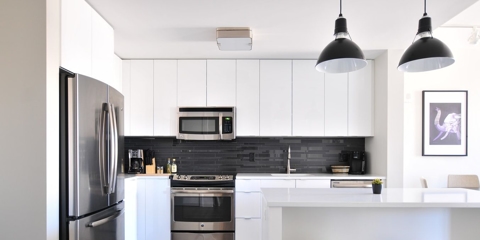As of October 2021, nearly 47% of young adults in America (aged 18 to 29) lived with their parents.
Moving out of your parents’ house is a big step. You’ll have privacy and independence, and you can live your life how you want to. However, you’ll also have a great deal more responsibility. You’ll be the one who needs to pay the rent or mortgage, keep the fridge stocked, and handle any repairs or maintenance on your property (or pay someone to do it).
Moving can also be a lot of work. It’s worth it, though, and that’s why we’ve compiled a list of a few steps to take so you can finally move out. Because when you plan ahead and do it right, moving out of your parents’ house can be the best thing that’s ever happened to you.
Step 1: Save, Save, Save
You're probably already financially independent if you're getting ready to leave your parents' house, but even local moves can be expensive if you're not careful. To get a head start on your move, have money saved to help you purchase all the necessities for your new home. It’s ideal to have at least three months of living expenses in savings.
Saving money isn’t always easy, and many people live paycheck to paycheck. The good news is that, if you’re currently living with your parents, you might not have a rent payment at all. You might not even have to pay for your food or insurance. Take advantage of this while you can by saving your money. Soon enough, you’ll have to start paying for these things. Cut back in other areas (think making coffee at home instead of getting a latte every morning) and put as much in savings as you can. It can make all the difference when you move out on your own!
Step 2: Create a Budget
Creating an overall budget is a great way to know what you can afford and what to expect after you move out of your parents’ house. To budget your list of necessities, it is helpful to look back at your old statements and record how much you spend in a month. This way, you will have a realistic idea of how much you already spend, what areas you can cut down on, and how much you will need to spend on new items for your home. You should also consider every expense after you move out, like rent/mortgage, utilities, insurance, groceries, and more. Write everything down and break it down by month or by paycheck so you know what’s coming in and what you’ll have to spend.
The following are examples of fixed costs to include in your monthly budget:
- Rent/mortgage payment
- Utilities
- Internet
- College loans
- Car loan/lease payment
- Insurance (car, medical, and renters’/homeowners’)
- Gym membership
The following are costs that may change from month to month:
- Groceries
- Clothes
- Gas
- Gifts (birthday presents, holidays, etc.)
- Entertainment (movies, concerts, eating out, etc.)
When you have a budget, you’re more likely to live within your means. This can help you save money in the long run, which is a must when you’re living on your own!
Step 3: Identify What You Will Need When Moving Out
Now that you have completed your savings and budgeting, it is time to identify the things you will need when moving out. Unless your parents or other loved ones are gifting you with necessities like pots and pans, utensils, and furniture, you’ll basically be starting from scratch. These include the “not so fun” stuff such as toilet paper, a trash can, trash bags, utensils, etc. It is helpful to make a list of these necessities to make sure you have everything you need once you are ready to move in. Make sure you have a list of all the appliances you'll need; it's easy to take toasters for granted when you've never had to buy one.
The following is a list of items often needed when moving out on your own:
- Furniture (couch, coffee table, kitchen table and chairs, bed, dresser, desk, nightstand, etc.)
- Appliances (washing machine and dryer, refrigerator, microwave, toaster oven, mixer, etc.)
- Pots and pans
- Kitchen utensils
- Kitchen trash can
- Dishes, silverware, cups, and food storage containers
- Pillows, sheets, blankets, and towels
- Laundry basket/hamper
- Television
- Cleaning supplies
- Set of basic tools (hammer, nails, screwdriver, measuring tape, etc.)
- Toilet paper, paper towels, sponges, and soap
- Step stool or ladder
- First-aid kit and medicine cabinet essentials (ibuprofen, cold medicine, thermometer, etc.)
- Fire extinguisher
Some appliances, like a refrigerator, will already be included in the home or apartment you’re moving into. It’s important to double-check before you move, so you know what you need. You can also check with your parents to see if you can bring your bedroom furniture set, which would save you from purchasing those items!
Step 4: Get Ready for Moving Day
Once you have a budget and know what you’ll need to spend to get into your new place, you can get ready for the big day. Set your moving day, make sure your utilities are all set up, and that everything you need can be delivered when you need it. If you only have a few things of your own that you’re bringing to your new place, you might be able to enlist friends and family to help you move. If you have furniture, books, and a lot of personal belongings, however, you might want to consider hiring a professional moving company.
Affordable Quality Moving and Storage can handle any size move in Southern California, across the U.S., or even internationally. Our Santa Clarita movers have been serving customers since 1996, and we offer complete packing/unpacking, moving, and storage services for any local, out-of-state, or long-distance move. If you’re moving out of your parents’ house, you have a lot to look forward to. Let our team handle the heavy lifting so you can focus on your new life!
Call (661) 622-2636 or contact us online for your free estimate.



.jpg)
